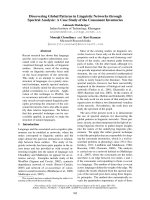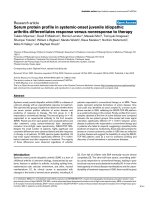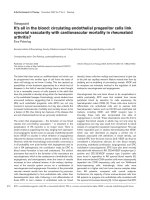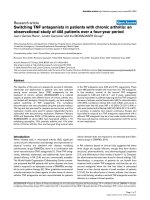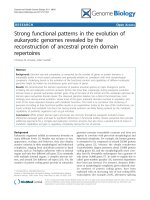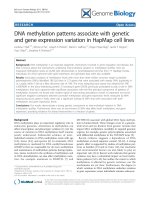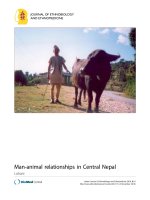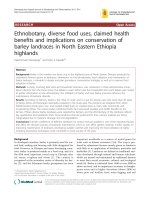Báo cáo y học: "Age-specific mortality patterns in Central Mozambique during and after the end of the Civil War" ppt
Bạn đang xem bản rút gọn của tài liệu. Xem và tải ngay bản đầy đủ của tài liệu tại đây (300.89 KB, 6 trang )
RESEARC H Open Access
Age-specific mortality patterns in Central
Mozambique during and after the end of the
Civil War
Bruce H Noden
1*
, R John C Pearson
2
and Aurelio Gomes
3
Abstract
Background: In recent years, vigorous debate has developed concerning how conflicts contribute to the spread of
infectious diseases, and in particular, the role of post-conflict situations in the epidemiology of HIV/AIDS. This study
details the age-specific mortality patterns among the population in the central provincial capital of Beira,
Mozambique, during and after the Mozambican civil war which ended in 1992.
Methods: Data was collected from the death register at Beira’s Central Hospital between 1985 and 2003 and
descriptively analyzed.
Results: The data show two distinct periods: before and after the peac e agreements in 1992. Before 1992 (during
the civil war), the main impact of mortality was on children below 5 years of age, including still births, accounting
for 58% of all deaths. Afte r the war ended in 1992, the pattern shifted dramatically and rapidly to the 15-49 year
old age group which accounted for 49% of all deaths by 2003.
Conclusions: As under-5 mortality rates were decreasing at the end of the conflict, rates for 24-49 year old adults
began to dramatically increase due to AIDS. This study demonstrates that strategies can be implemented during
conflicts to decrease mortality rates in one vulnerable population but post-conflict dynamics can bring together
other factors which contribute to the rapid spread of other infectious diseases in other vulnerable populations.
Background
In recent years, vigorous debate has developed concern-
ing how conflicts contribute to the spread of infectious
diseases, and in particular, the role of post-conflict situa-
tions in the epidemiology of HIV/AIDS [1-3]. It has
been widely assumed that the disarray accompanying
conflicts contributes significantly to the spread of HIV
in local population [4]. However, others have shown
that the spread of HIV occurs primarily in the post-con-
flict period when the isolation of the population is
removed and the freedom to travel improves [1,4,5].
Central Mozambique is a unique place in wh ich to eval-
uate the relationship between conflict and mortality
related to infectious diseases as an extended civil war
ended in 1992. The aim of this retrospective study was
to detail the age-specific mortality patterns among the
population in the central provincial capital of Beira,
Mozambique, during and after the Mozambican civil
war.
Methods
Setting
Beira, Moza mbique, the provincial capit al of the central
province of Sofala, is situated on the Indian Ocean.
Since the 1950s, Beira has served as the major port city
for the landl ocked neighbouring countries of Zimbabwe,
Zambia and Malawi. During the civil war which began
in 1976, Beira was relatively isolated, except for the
influx of truckers and military personnel from neigh-
bouring countries of Zimbabwe, Zambia and Malawi
assisting to keep the ‘ Beira Corridor’ open to trade.
When the peace accords were signed in 1992, Mozambi-
que was one of the poorest countries in the world [6].
The city now has a population of 432,000 [7] and is
now considered the third largest city in Mozambique.
* Correspondence:
1
Department of Biomedical Science, School of Health and Applied Science,
Polytechnic of Namibia, Windhoek, Namibia
Full list of author information is available at the end of the article
Noden et al. Conflict and Health 2011, 5:8
/>© 2011 Noden et al; licensee BioMed Central Ltd. This is an Open Access article distributed under the terms of the Creative Commons
Attribution License ( which permits unrestricted use, distribution, and reproduction in
any medium, provided the origina l work is prop erly cited.
The Central Hospital of Beira is one of only 3 central
hospitals in Mozambique [8]. While serving as a primary
(local) and secondary (provincial) medical centre for one
of the largest urban populations in Mozambique, it also
acts as a tertiary referral centre for Central Mozambique
[9]. It is the main training centre [8] with an associated
medical school (Catholic University of Mozambique
Faculty of Health Sciences) since 2001. Therefore , it is a
major catchment hospital for critical cases from which
mortality studies are appropriate.
Data collection
Data for this study was collected from the death register
at Beira’s Central Hospital. All deaths are required by
law to be registered before burial. Therefore, the data
from the Central Hospital ensures that most deaths
occurring between 1985 and 2003 were recorded.
The population of Beira was not precisely known until
the first census in 1997. At that time, general estimates
were made for both the province of Sofala (of which
Beira is the capital) and the city of Beira [10]. The per-
centage distribution of mortality was accordingly com-
piled using published age distribution categories [11].
This study was part of an outreach program of the
Faculty of Health Sci ences of the Cat holic University of
Mozambique. The medical students involved in the data
collection were closely supervised by experienced nurses
and the complete anonymity of the names in the regis-
ter was ensured at all times. The overall supervision was
done by an experienced physician.
For this study, data from the death registers was trans-
ferred to worksheets providing information of register
number, sex, age, place of birth, place of res idence, date
of death and diagnosis. All data was then coded using
ICD-10, three digits, entered into Excel worksheets and
converted to an Access database, closely supervised by a
physician. For the current study, only age was analyzed.
Wheretheageatdeathwasnotknown,thediagnosis
was checked, and if indicative of the age category (e.g.
born dead or premature), the death was recorded. If
not, ‘ unknown’ age was recorded. Analysis was per-
formed using EPI Info version 3.2 and graphs created
using Excel 2007.
Results
Between 1985 a nd 2003, there was a dramatic shift in
theage-specificmortalitypatterns in populations in
Beira, Mozambique ( Figure 1). This shift was most
obviously observed in the increase in the median age of
mortality (Figure 2). As infant mo rtality rates were
decreasin g, there was a substantial increase in mortality
among 25-49 year olds (Figure 3). In terms of actual
population, total numbers of deaths in Beira incre ased
2.3 × between 1985 (2450) and 2003 (5605). While
Under-5 mortality remained relatively constant (n =
1429 (1985) to n = 1479 (2003), mortality among the
24-49 year olds went from 408 (1985) to 2197 (2003)
(an increase of 5.4×). By 2003, mortality rates among
the 15-49 year olds accounted for ~60% of all deaths
(Figure 1).
In 1985, main causes of death among 15-49 year olds
were tuberculosis (15%), anaemia (8%), and gunshots
wounds (7%) (Figure 4). Patterns changed slightly in
1992 with tuberculosis (14%), anaemia (8%), malaria
(8%), and gastroenteritis (not cholera) (6%). Only two
deaths were ascribed to HIV/AIDS. By 2003, AIDS/
Immunodeficiency accounted for 29% of deaths followed
by tuberculosis (18%) and malaria (18%).
TheinfantmortalityrateinBeirawas65.8(per1000)
in 1997, but fell to 38.2 in 2001 and 38.0 in 2003. Also,
the child mortality rate (1-4 year olds) fell from 13.0
(2001) to 9.4 (2003). While the mortality rates for 5-14
year olds remained stable (1.7/1000) between 200 1 and
2003, there was a small rise in the mortality rates
among 15-24 year olds from 3.6 to 5.0 and even larger
increases for the 25-49 year old group (9.0 to 13.1), the
50-64 age group (11.2 to 23.6) and in those older than
65 (40.3 to 57.8).
Intere stingly, while the Beira infant mortality rate (per
1000) fell from 65.8 in 1997 to 38.2 in 2001, the overall
mortality rate for Sofala province dropped from 144
(1997) to 128 (2003). When Beira was excluded, the
mortalityratefortherestofprovinceofSofalahardly
changed from 167 (1997) to 164 (2003).
Discussion
The data suggest two major trends occurred in the
Mozambique between 1985 and 2003. T hese trends
demonstrate the issues impacting conflict and post-co n-
flict situations [1,4,5]. First, during the civil war (before
1992), mortality was highest among children below 5
years of age (including still births), accounting for two
thirds of all deaths. T his reduction is confirmed by
Cutts et al. [12] in an epidemiological study done in the
communities of Beira during that period. The low mor-
tality rate among 15-49 year olds during the same per-
iod is notable, p articularly during a time of c onflict.
Because of the poor state of the health services in Cen-
tral Mozambique due to the destruction of most rural
health posts, the primary focus of humanitarian organi-
zations (i.e. International Committee of the Red Cross
(ICRC)) was to reduce maternal and child-related mor-
tality [13]. The ov erall effect was a dramatic decrease in
mortality in the under-5 children in Central Mozambi-
que [13] and Southern Mozambique [14] which is also
observable in this Beira Central Hospital data set.
The post-conflict trend occurred 5 years after the civil
war ended (post-1992) when the mortality pattern
Noden et al. Conflict and Health 2011, 5:8
/>Page 2 of 6
dramatically shifted to those older than 15 years old, with
the greatest impact occurring among 25-49 year olds.
During this period, the main cause of death was attribu-
ted to AIDS. Until the late 1996, the epidemiology of
HIV infections in Central Mozambique was unknown.
Routine testing for HIV among pregnant females was
implemented in Maputo (the capital of Mozambique) in
1986. However, it did not begin in Beira until 1996 [15].
During these 10 years of non-monitoring, HIV expanded
dramatically in Central Mozambique. By 1996, 17% of
the pregnant women in Beira were already infected with
HIV. This was also found in other major urban centers
in Central Mozambique, Chimoio and Tete, with HIV
prevalences of 19.2% and 22.5%, respectively among preg-
nant women. As of 2006, the HIV prevalence rate in
Mozambique was 16.2% [15] with the highest HIV preva-
lence registered in the central province of Sofala with an
official rate of 26.5%, with Beira registering 38% [15].
0%
10%
20%
30%
40%
50%
60%
70%
80%
90%
100%
1985
1988
1992
1997
2000
2003
Cumulative % of deaths
65 +
50-64
25-49
15-24
10-14
5-9
1-4
0-1
Figure 1 Age-specific mortality in the city of Beira, Mozambique, 1985-2003.
5yearsold
9yearsold
20yearsold
28yearsold
29yearsold
0
5
10
15
20
25
30
35
1985 1992 1995 1997 2003
Figure 2 Median age of mortality in the city of Beira, Mozambique, 1985-2003.
Noden et al. Conflict and Health 2011, 5:8
/>Page 3 of 6
From this data, it is apparent that during the conflict
stage, the government and humanitarian groups focus ed
to ensure appropri ate healt h care to the under-5 cohort
in the early 1990s (a component more easily addressed
during the conflict stage). During the same conflict per-
iod, unmonitored HIV spread rapidly among vulnerable
populations in Central Mozambique. While truck drivers
and military personnel from neighbouring countries
with high HIV prevalence [16-19] may have brought the
HIV to relatively isolated urban populations [1], local
populations were primed for an HIV epidemic because
of high prevalence of untreated STIs [20,21]. Addition-
ally, after the peace accords in 1992, large numbers of
refugees returned from neighbouring countries [16-18]
with unknown HIV prevalence. We believe that the mix-
ing of HIV-infected refugees into the these relatively iso-
lated communities with high prevalence of untreated
STIs [4,22] contribute d to the explosion of HIV which
culminated in increased AIDS mortality in Central
Mozambique in mid-to-late 1990s. Finally, the influx of
UN peacekeepers in 1993 with their perceived wealth
and the creation of a large commercial sex industry in
Beira, may have also contributed to the spread of HIV
in the community [4]. The Mozambique national pro-
gram for HIV prevention only began to respond in Cen-
tral Mozambique in 1999 while it had been actively
working in Maputo since 1986.
While possible limitations occurred, every effort was
made to reduce their effects. One limitation is the possi-
ble bias introduced into the analysis by misreporting of
the ages at death, particularly that of rounding of ages
at death. While common for mortality-focused studies
[23-25], this can underestimate the mortality of some
age groups and overestimate for others. However,
38%
22%
18%
13%
8%
19%
22%
30%
37%
39%
0%
5%
10%
15%
20%
25%
30%
35%
40%
45%
1985 1992 1997 2000 2003
0Ͳ1yrolds
25Ͳ49yrolds
Figure 3 Mortality rates (%) of prenatal (ages 0-1) and adults (ages 25-49) in Beira, Mozambique, 1985-2003.
1985
1
1992
2
2003
TB TB AIDS
Anaemia Anaemia TB
Gunshots wounds Malaria Malaria
1
- No AIDS recorded
2
- onl
y
2 cases of AIDS recorded
Figure 4 Top 3 causes of mortality among 15-49 year olds in Beira, Mozambique, 1985, 1992 and 2003.
Noden et al. Conflict and Health 2011, 5:8
/>Page 4 of 6
because of the large sample size used and the complete-
nessofthedataset,webelievethetrendswerenot
altered significantly by this possible limitation.
Another limitation involves the completeness of the
death registry from only one institution, even one as
regionally significant as B eira Central Hospital. A law
requires the registration of all deaths occurring in the
Beira area at the mortuary of the Central Hospital in
order to r eceive a certificate for a burial plot assigned
by an area municipal office [9]. It is not possible, how-
ever , to control for those who die at home and are bur-
ied in ‘informal’ cemeteries. In their 1996-1997 study in
Beira, Songane & Bergstrom [9] reported a high rate o f
underreporting of maternal deaths in the official regis-
ter. Apart from the four public cemeteries (one which is
already full), there are 1 0
+
private cemeteries in which
mortality information is not documented. The fact that
there were 2.3 × more recorded deaths in 2003 com-
pared with 1985 leads one to consider that misreporting
could have affected some of the patterns observed in
our study, particularly early during the conflict phase.
Another factor involves the contribution of reduced
under-5 mortality on the increased proportion of mor-
tality observed among 24-49 year olds between 1992
and 2003. From the data, we do not believe that this
reduction had much of an effect. Over the period of
study, o ur data records that under-5 mortality numbers
stayed relatively constant (while the proportion in the
mortality population decrease d) whereas the total mor-
tality among 15-49 year olds increased 5.4×. Where the
effect of a decrease under-5 mortality (observed locally
[13] and nationally [26]) may be seen is in the slight
increase of life expectancy rates in Mozambique from
42.7 (1985) to 47.6 (2003) [27].
It is notable that during the war period in the Beira
Central Hospital records, 58% (1985) to 50% (1992) of
the mortalities registered were children under 5 years
old. While gender was not a nalyzed for this study,
maternal mortality in Beira was estimated at 10.3% by
Cutts et al. [12] but the authors felt their informal
methods underestimated the true number. Even with
their conservative estimate, the combined child and
maternal mortality in Beira during the c ivil war years
was over 60% of the total mortality.
During the late 1980s, Central Mozambique was
involved in civil war which systematically focused on
rural health services [28]. Rural clinics were systemati-
cally destroyed and health workers were kidnapped or
killed. Ambulances and health vehicles were routinely
attacked and supply support systems to rural clinics
were seriously affected. Between 1983 and 1987, the
mortality rates of displaced persons were 2.7-6.3 times
higher than the national average. By 1987, trauma was
the leading cause of death among adults in Tete
province. This is observable in our data set with the
third highest cause of mortality in Beira in 1985 being
gunshot wounds. During this conflict period, 1.2 million
persons were displaced from their homes [28]. Because
of this massive disruption, Beira filled with persons
escaping from the unstable situation with many being
women and children. In 1993, Cutts et al. [12] deter-
mined that two major risk factors for child mortality in
Beira were recent migration (child born outside Beira)
and absence of a father. This indicates that women may
have been searching for sanctuary in Beira while men
were either fighting or workin g in neighboring coun-
tries. So, agreeing with conclusions raised by O’Hare
and Southall [29], this data re-emphasizes the impact of
conflict on maternal and child health and leads to a spe-
cial appeal to wealthy co untries who sell the weapons to
the warring groups in developing countries to consider
afresh what it means to ‘do no harm’ at the expense of
getting i ncome from weapon sales. With the end of the
war, there may have been a dramatic shift in population
with men returning which could have helped explain
some of the patterns observed in the late 1990s-early
2000s.
Even including th e other causes among the 24-49 year
olds in Beira, HIV/AIDS was the main cause of death in
the post-conflict period. The epidemic began ‘silently’ in
the population in the mid-1980s. By 2000, the HIV sero-
prevalence among pregnant women in Beira was just
under 30% [30]. Until the mid-2000s, it was considered
shamef ul to put AIDS as the cause of death on the reg-
ister. It is interesting to note in our data that until the
early 2000s, tuberculosis was the main cause of death
among 15-49 year olds. It begs the question of how
many of those deaths from tuberculosis were actually
caused by undiagnosed HIV/AIDS. However, while both
tuberculosis and malaria were significant among 15-49
year olds in 2003, HIV/AIDS quickly became the leading
cause. These mortality patterns among 15-49 year olds
were also corroborated by others inside Mozambique
[26,31] and in Southern Africa [14].
Conclusions
In conclusion, while much effort went into reducing the
mortalityofchildrenunder5atthecloseofthe
Mozambique civil war, a silent HIV epidemic had
already entered into relatively isolated communities.
Without an HIV prevention strategy in place, the influx
of refugees from neighbouring countries with high HIV
rates together with local populations with high STI rates
worked together to significantly impact adult mortality
in the post-conflict state. This demonstrates that during
conflicts, resources can be focused to reduce mortality
rates in one population cohort. However, the dynamics
in the immediate post-conflict period can bring together
Noden et al. Conflict and Health 2011, 5:8
/>Page 5 of 6
other factors which contribute to the rapid spread of
different infectious diseases in vulnerable populations,
thus nullifying the previous gains.
Acknowledgements and Funding
Our grateful thanks to Rev. Dr. Fransisco Ponsi and Rev. Dr. Elias Arroyo for
their encouragement and assistance. Special thanks for the assistance to Mr.
Joaquim Chitejo Gotine, Conservador, 1
st
Conservatoria do Registo Civil in
the city of Beira as well as the first graduating class of medical students of
the Catholic University of Mozambique. BHN would like to specifically thank
his colleagues in both AIM International (Mozambique) as well as UCM for
the many helpful discussions in putting these ideas together. Salary support
for AG during part of this study was funded by CIPRA (National Institutes of
Health, USA #1 R03 AI056325-01).
Author details
1
Department of Biomedical Science, School of Health and Applied Science,
Polytechnic of Namibia, Windhoek, Namibia.
2
Department of Community
Medicine, West Virginia University, West Virginia, USA (Emeritus Profess or.
3
World Learning, Washington, DC, USA.
Authors’ contributions
The three authors participated in designing the study. AG organized the
data collection. RJCP carried out the data analysis. BHN drafted the first
version of the paper. All authors extensively reviewed all drafts, made
comprehensive changes, and approved the final draft.
Competing interests
The authors declare that they have no competing interests.
Received: 20 January 2011 Accepted: 26 May 2011
Published: 26 May 2011
References
1. Mock NB, Duale S, Brown LF, Mathys E, O’Maonaigh HC, Abul-Husn NKL,
Elliott S: Conflict and HIV: A framework for risk assessment to prevent
HIV in conflict-affected settings in Africa. Emerg Themes Epi 2004, 1:6.
2. Becker JU, Theodosis C, Kulkarni R: HIV/AIDS, conflict and security in
Africa: rethinking relationships. J Int AIDS Society 2008, 11:3.
3. Checchi F, Colombo S, Paik E: Health-care needs of people affected by
conflict: future trends and changing frameworks. Lancet 2010,
375:341-345.
4. Becker JU, Drucker E: A paradoxical peace: HIV in post-conflict states. Med
Conflict Survival 2008, 24:101-106.
5. Strand RT, Dias LF, Bergstrom S, Andersson S: Unexpected low prevalence
of HIV among fertile women in Luanda, Angola. Does war prevent the
spread of HIV? Int J STD AIDS 2007, 18:467-471.
6. UNECA: Poverty Reduction in Southern Africa A Sub-regional Brief. 1999
[ />htm].
7. INE (Instituto Nacional de Estatistica): 3° Recenseamento Geral da
População e Habitação: Base dos dados. Mocambique, Maputo; 2007
[ />8. Dos Santos C, Diante D Jr, Baptista A, Matediane E, Bique C, Bailey P:
Improving emergency obstetric care in Mozambique: The story of
Sofala. Int J Gyn Obs 2006, 94:190-201.
9. Songane FF, Bergstrom S: Quality of registration of maternal deaths in
Mozambique: a community-based study in rural and urban areas. Soc Sc
Med 2002, 54:23-31.
10. INE (Instituto Nacional de Estatistica): Recenseamento Geral de Populacao
e Habitacao 1997: Indicadores Socio-Demograficos. Mocambique,
Maputo; 1999.
11. INE (Instituto Nacional de Estatistica): 1. Tamanho, Estrutura e Crescimento
da População. 1997 [ />recenseamento_geral/estudos_analise/pais 4/view?searchterm=censo%
201997].
12. Cutts FT, Dos Santos C, Novoa A, David P, Macassa G, Soares AC: Child and
Maternal Mortality during a period of conflict in Beira City, Mozambique.
Int J Epi 1996, 25(2):349-356.
13. Coninx R, Dupuy C: Effects of the civil war in Central Mozambique and
evaluation of the intervention of the International Committee of the
Red Cross. J Trop Pediatrics 1997, 43:318-323.
14. Nhacolo AQ, Nhalungo DA, Sacoor CN, Aponte JJ, Thompson R, Alonso P:
Levels and trends of demographic indices in southern rural
Mozambique: Evidence from demographic surveillance in Manhica
district. BMC Pub Health 2006, 6:291.
15. MISAU: Apresentacao de HIV em Sofala, CNCS (National Program to
Control STI/HIV/AIDS). Beira, Mocambique; 2006.
16. Glynn JR, Crampin AC, Ngwira BMM, Mwaungulu FD, Mwafulirwa DT,
Floyd S, Ponnighaus JM, Warndorff DK, Fine PEM: Trends in tuberculosis
and the influence of HIV infection in northern Malawi, 1988-2001. AIDS
2004, 18:1459-1463.
17. Mahomva A, Greby S, Dube S, Mugurungi O, Hargrove J, Rosen D,
Dehne K-L, Gregson S, St Louis M, Hader S: HIV prevalence and trends
from data in Zimbabwe, 1997-2004. Sex Transm Infect 2006, 82(Suppl I):
i42-i47.
18. Smith J, Mushati P, Kurwa F, Gregson S, Lopman B: Changing patterns of
adult mortality as the HIV epidemic matures in Manicaland, eastern
Zimbabwe. AIDS 2007, 21(Suppl 6):S81-S86.
19. Ba O, O’Regan C, Nachega J, Cooper C, Anema A, Rachlis B, Mills EJ: HIV/
AIDS in African militaries: an ecological analysis. Med Conflict Survival
2008, 24(2):88-100.
20. Vuylsteke B, Bastos R, Barreto J, Crucitti T, Folgosa E, Mondlane J,
Dusauchoit T, Piot P, Laga M: High prevalence of sexually transmitted
diseases in a rural area in Mozambique. Genitourin Med 1993, 69:427-430.
21. Cossa HA, Gloyd S, Vaz RG, Folgosa E, Simbine E, Diniz M, Kreiss JK: Syphilis
and HIV infection among displaced pregnant women in rural
Mozambique. Int J STD AIDS 1994, 5(2):117-23.
22. Mworozi EA: AIDS and civil war: a devil’s alliance. Dislocation caused by
civil strife in Africa provides fertile ground for the spread of HIV. AIDS
Anal Afr 1993, 3(6):8-10.
23. Coale AJ, Li SM: The effect of age misreporting in China on the
calculation of mortality rates at very high ages. Demography 1991,
28(2):293-301.
24. Curtis SL: Assessment of the quality of data used for estimation of infant
and child mortality in DHS-II surveys. Occasional papers No 3 Calverton,
MD: Macro International; 1994.
25. Macassa G, Ghilagaber G, Bernhardt E, Burstrom B: Trends in infant and
child mortality in Mozambique during and after a period of conflict.
Public Health 2003, 117:221-227.
26. WHO: Mortality Country Fact Sheet: Mozambique. 2006 [.
int/whosis/mort/profiles/mort_afro_moz_mozambique.pdf].
27. World Bank: World Development Indicators. 2011 [ldbank.
org/indicator/SP.DYN.LE00.IN/countries/MZ?page=1 &display=map].
28. Cliff J, Noormahomed AR: Health as a target: South Africa’s
destabilization of Mozambique. Soc Sci Med 1988, 27:717-722.
29. O’Hare BAM, Southall DP: First do no harm: the impact of recent armed
conflict on maternal and child health in Sub-Saharan Africa. J Royal Soc
Med 2007, 100:564-570.
30. Multisectorial Technical Group: Report of the Update of the HIV
Epidemiological Surveillance Data - 2004 Round. Republic of
Mozambique, Ministry of Health, National Directorate of Health, National
STD/HIV-AIDS Control Programme, Maputo; 2005.
31. Dgedge M, Novoa A, Macassa G, Sacarlal J, Black J, Michaud C, Cliff J: The
burden of disease in Maputo City, Mozambique: registered and
autopsied deaths in 1994. Bull WHO 2001, 79:546-552.
doi:10.1186/1752-1505-5-8
Cite this article as: Noden et al.: Age-specific mortality patterns in
Central Mozambique during and after the end of the Civil War. Conflict
and Health 2011 5:8.
Noden et al. Conflict and Health 2011, 5:8
/>Page 6 of 6


